Machines have made our life easier and comfortable. Whether outside or inside, machines have become an indispensable part of our daily lives. Needless to say, science has made it possible for us. With its ever-developing technology, science has changed and shaped our ways of living. Refrigeration is one revolutionary invention that has changed the way we live.
For all of us, it has made it possible to preserve for days. Indeed, it is one such machine which is very useful. They are used in the household as well as in industry and commerce. But do you know how a refrigerator works? What is the best refrigerator? Let us see the working principle of the refrigerator and refrigerator working process.
Table of Contents
What is a Refrigerator?
As per the dictionary, a refrigerator
- It is kitchen equipment used by us to preserve our food at a cold temperature.
- It uses electricity to run.
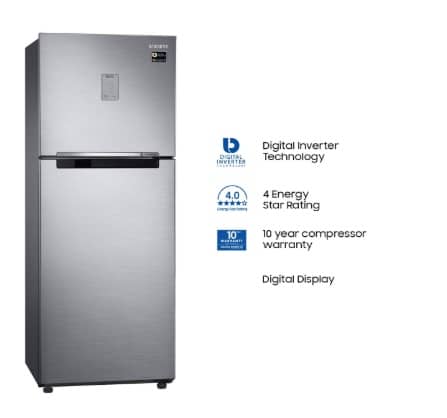
LG 8 Kg, 5 Star, Wi-Fi, Direct Drive Technology, Steam Wash, 6 Motion DD, Fully-Automatic Front Load Washing Machine (FHB1208Z4M, Allergy Care, In-Built Heater, Touch Panel, Middle Black)
What is the function of the refrigerator?
Before we talk about the Working Principle of the Refrigerator, we will discuss the function of a refrigerator.
- The fundamental reason behind keeping a fridge is that it keeps your food cool.
- The cold temperature helps to keep the food fresh for a long time.
- Refrigeration slows down the activity of bacteria present in the food so that the bacteria take time to spoil the food.
For example, if we leave milk outside the fridge at room temperature for 2-3 hours, it gets spoiled. Keeping it in the fridge will reduce the temperature of the milk, and it stays fresh for more than a week. So, the refrigerator working principle is: the cold temperature of the milk decreases the bacteria’s activity.
Related Reading:
How Much Electricity Does A Fridge Use: Let’s Find it out?
History
Before we learn about the Working Principle Of The Refrigerator, let us know about its history. Previously, when machines and science didn’t take over our lives, people used the natural way to do things. They used to bring down the temperature naturally. In winter, people harvested ice from rivers and lakes. They kept it in the ice houses until it was required in summer. These ice houses were used for most of the year for cold storage. Later in the early 17th century, the word “refrigeratory” was used.
In 1755, Scottish professor William Cullen designed a small refrigerating machine, which slowly changed the world.
So,
What was the refrigerator mechanism?
-
- He used an ancient method of refrigeration known as cooling by evaporation.
- He created a partial vacuum in a container containing diethyl ether by using a pump.
- Diethylz ether started to boil and required energy to evaporate.
- Gradually, it started absorbing heat from the surrounding air by lowering the temperature of the air.
- Thus, a meager amount of ice was produced, and this gave birth to artificial refrigeration.
Sadly, it had no practical application at that time. It couldn’t be used for cooling, but it was a stepping stone towards the artificial working of a refrigerator.
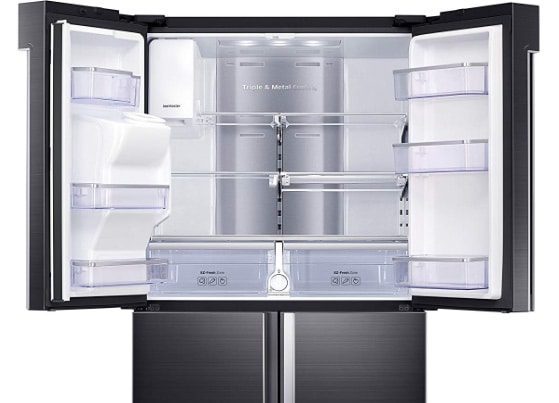
Later on, scientists, engineers, and physicists worldwide kept on experimenting and developing the system. They were-
- American inventor Oliver Evans, in 1805, produced ice by ether under vacuum.
- In 1820, Michael Faraday, a British scientist, used high and low pressures to liquify ammonia and other gases.
- Jacob Perkins, in 1834, designed the first working vapor-compression refrigeration working. It could operate continuously due to its closed-cycle feature.
- John Gorrie, an American physician in 1842, tried to build a prototype, but it was a big commercial failure.
- James Harrison was the first person to build the first practical vapor compression refrigerator. He also introduced a commercial vapor compression fridge to commercial places like breweries and meatpacking houses. By 1861, many of his systems entered into commercialization and started to operate.
- Ferdinand Carre in 1859 developed the first gas absorption system using (aqua ammonia) gaseous ammonia dissolved in water and gave the patent in 1860.
- In 1876, an engineering professor Carl von Linde improved the method of liquefying gases. He used gases, such as ammonia, sulphur dioxide, and methyl chloride as refrigerants. These gases were widely used until the 1920s.
How does a refrigerator work?
There are three steps to how the fridge works-
- When food items are kept in the fridge, the cool refrigerant is passed.
- The heat from the food items is absorbed by the refrigerant.
- The heat absorbed by the refrigerant gets transferred to the relatively cooler surroundings outside.
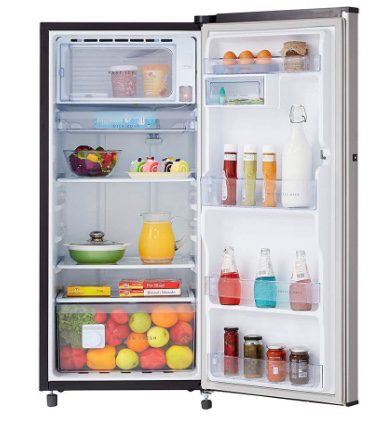
What is the working principle of the refrigerator?
The working principle of refrigerator is a simple one-
- It removes heat from one region and deposits to another region.
- If one passes a low-temperature liquid close to a liquid substance that one wants to cool, heat from those objects gets transferred to the liquid. In that process, it evaporates and takes away the heat.
If you compress the gas, it warms up and cools down when it is expanded. The same principle is applicable when a bicycle pump feels warm when one uses a pump to pump air inside it, whereas it feels cold when one sprays perfume. This principle of Physics, along with the help of a few components, helps the fridge keep the food cool.
Know how star rating can impact your electricity bill?
What is the working of refrigeration system?
- The refrigerant circulates inside the fridge by changing the state of liquid to gas. This process is called evaporation. It cools the surrounding area and produces the desired effect. You can understand this by doing a simple experiment. Put a few drops of alcohol on your skin. You will feel a chilling sensation as it evaporates. This is the basic principle that gives proper food storage.
- To keep the fridge working, the refrigerant’s pressure is reduced through an outlet called a capillary tube. The pressure needs to be reduced to start the evaporation and change the refrigerant from liquid to gas. Example-The same thing happens with your body/hair spray. The contents inside the bottle are the pressure or liquid. The outlet is the capillary tube, and the open space is the evaporator. It turns from liquid state to gas when we release the liquid/pressure into the lower pressure open space.
- The gas refrigerant needs to be back to the liquid state. For that, the compressor compresses the gas to a higher pressure and temperature. A similar effect is felt with the bike pump. You can understand that the heat increases while you pump and compress the air.
- The gas gets heated up and is under high pressure. This needs to be cooled down in the condenser. This is present on the back of the refrigerator so that the air can cool the contents.
- The condenser cools off the gas inside and thus changes back into the liquid.
- This changed liquid refrigerant goes back to the refrigerator evaporator, and then the same cycle starts over once again. This keeps the refrigerator working.
This is the mechanism of refrigerator. The process seems to be complicated, but it’s based on principles of science, making it possible.
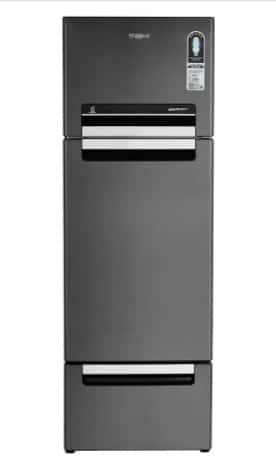
What is the principle of refrigeration?
As now we know about the Working Principle Of Refrigerator, let us talk about the refrigerator principle. It uses the principles of
- Pressure
- Condensation
- Evaporation of a fluid in a closed circuit to remove heat and reduce the temperature inside it.
What are the refrigerator components and their working?
So, we already know how refrigerator works and its fridge working principle. The fridge maintains a low temperature to reduce the growth of harmful bacteria. The working of refrigerator is that it transfers the inside heat to the outer environment. When you touch the backside of the fridge or near the metal pipes, you feel warm.
There are 5 components in a fridge.
These are
- Compressor
- Condenser
- Evaporator
- Capillary tube
- Thermostat
- Capacity control system
- Receiver
1. Compressor
- It is the heart of the fridge.
- The compressor circulates the refrigerant throughout the system.
- It makes the refrigerator hot by putting pressure on the warm part of the circuit.
- It consists of a motor that sucks in the refrigerant from the evaporator and compresses to make a hot and high-pressure gas.
- It can compress and convert low-temperature to high-temperatures.
- It causes an increase in pressure, and heat can be easily released.
2. Condenser
It sits in the back of the fridge.
- It extracts heat from the refrigerant.
- It cools down the refrigerant and changes the matter. That means it changes gas back into liquid. This is the refrigerator cooling system.
- Fans above the condenser unit draw air over the condenser coils. These fans are placed above the condenser.
- -12 degree to -1degree C should be the range of temperature of condensation.
- The vapor cools down to become liquid refrigerant.
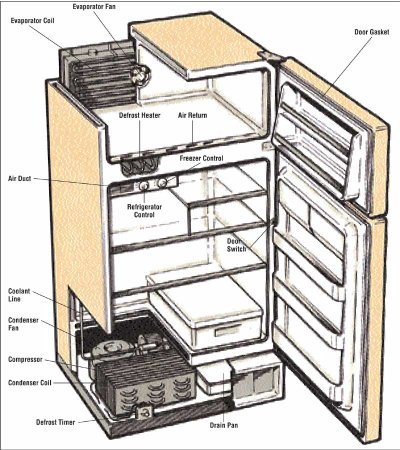
3. Evaporator
- The evaporator in the refrigerator is located inside a fridge and makes the items in the refrigerator cold.
- It removes the unwanted heat from the food items through liquid refrigerant.
- The pressure of the liquid refrigerant must be low.
- Two factors determine the low pressure- first, heat gets absorbed from the product to the liquid refrigerant and the second one is the removal of air pressure by the compressor.
- Through evaporation, the refrigerant turns liquid into a gas and cools down the area. Hence, it produces the appropriate environment for storing and preserving food.
4. Capillary tube
- It is an expansion device and a thin piece of tubing.
- Through the capillary tube, the liquid refrigerant is routed and sprayed into the low-pressure environment of the evaporator.
5. Thermostat
- It controls the cooling process in the fridge by monitoring the temperature and switching the compressor on and off.
- When it’s cold enough inside the fridge, the sensor can sense that and turn off the compressor.
- When it senses too much heat, it switches the compressor on, and the cooling process begins again.
6. Capacity control system
- It regulates the power and energy consumption
- It manages dehumidification and decreases the compressor cycling.
- It has an on/off option, which is the simplest form of capacity control.
7. Receiver
- The receiver acts as a vapor seal.
- These are made for both horizontal and vertical installation.
Working principle of refrigerator with diagram
The following diagram shows a visual representation of how does a refrigerator works. The diagram shows the components that make a fridge and how they fit into the cabinet. The arrows are given to make the visual clear.
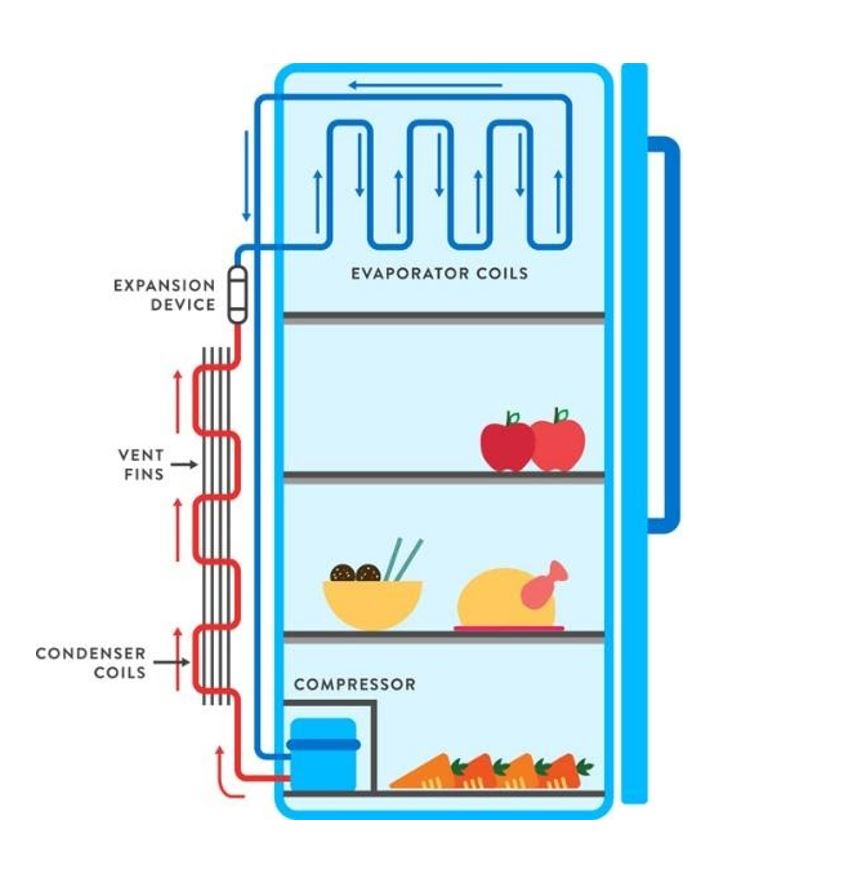
The working of domestic refrigerator
- The compressor and the electric motor are placed in a single enclosed container.
- The compressor used in the fridge is a reciprocating type.
- There are no moving parts in a domestic fridge except the compressor. That’s why this type of fridge lasts long.
- The capacity of the fridge is defined as liter. The liter is the volume of storage space.
Conclusion
Nature has its own way of guiding us. A simple natural phenomenon led to the working principle of refrigerator. It is interesting to see how William Cullen’s invention and curiosity led to the fridge’s working principle. And later, eminent scientists and engineers continued to work on that principle.
Today, we have a perfectly working fridge working and preserving food for us. This was about refrigerator and its components, refrigerator function, refrigerator working principle, diagram of working refrigerator, and how do refrigerators work.















